by Dmitry Kirsanov
8. September 2014 22:09
If you are curious enough to develop software for Windows Phone, Microsoft got few surprises for you, which you may or may not already noticed, depending from how often you publish your apps.
First and the most important change is that Microsoft stopped testing new apps. Completely. This improved the speed of application submission from 3-7 days to 10-20 minutes. No one is going to check your app for compliance to UI, security and usability guidelines, as Microsoft has way more serious problems to solve – abysmal market share of just 2.5% and huge gap in apps with Google Market. And high quality, as you know, is an enemy of high speed, unless is backed by increased budget. Since Microsoft doesn’t yet control your budget, all they could offer is to help the speed of submission by eliminating the quality fence.
The downside of this is lowered quality of apps. For example, I released an application, which successfully completed the certification and was published in about 15 minutes, but failed to even start. That’s right, it produced exception right on start, no welcome screen or splash. More...
by Dmitry Kirsanov
28. July 2014 11:15
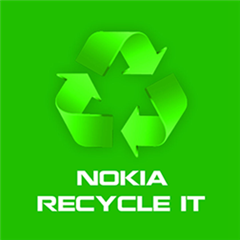 A year ago I started an experiment. I've got myself a Windows Phone. I wanted to see if I can be happy enough to keep is as a replacement for an Android phone, and whether I could develop anything that I would miss in that platform. And so I've got myself an HTC 8X.
A year ago I started an experiment. I've got myself a Windows Phone. I wanted to see if I can be happy enough to keep is as a replacement for an Android phone, and whether I could develop anything that I would miss in that platform. And so I've got myself an HTC 8X.
The phone itself, speaking about hardware, is pretty good. Apart from lack of microSD card slot and accidental restarts due to badly designed SIM slot, everything was perfect.
Pretty soon I realized, that things I could develop are either restricted by operating system, or would require support by third parties. So although I developed what I liked, it didn't really cover my user requirements, and with time I started to carry my old Android phone with me. Not to make calls, but simply for apps and internet for these apps.
A year later, I think it's time to draw the line and write down my experiences with Windows Phone. I think they might be interesting for you if you have no to little experience with Windows Phone and wondering what it's like and whether it’s worth trying.
First, here is a simple list of things that I, as a normal user, can and can not do with two mobile operating systems - Android and Windows Phone. Since this question is very popular and human memory is usually very slow, I decided to write down the points that justify me carrying an Android phone in a backpack. More...
by Dmitry Kirsanov
1. September 2013 08:33
 It finally happened - I am releasing my first application for Windows Phone 8. And Windows Phone 7.1, for a change. Taking into account the average (in all meanings of that word) quality of applications in Windows Phone Store, I should be proud of myself.
It finally happened - I am releasing my first application for Windows Phone 8. And Windows Phone 7.1, for a change. Taking into account the average (in all meanings of that word) quality of applications in Windows Phone Store, I should be proud of myself.
If, by chance, you own a Windows Phone device, and in need of a currency converter for Windows Phone, I highly recommend this app, as it’s the most advanced one in the store at the moment, and will become even more useful in time.
Here are the few images of it that you can also see at the store:
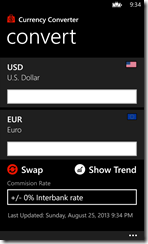
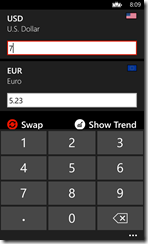
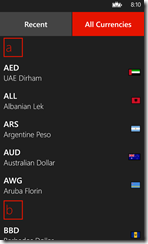

I really like how it looks and works so far. Planning to release its Windows 8 analogue in a few days.
If you are planning to give it a try, let me know what you think and what else you’d like to see in it. Your feedback is important!
by Dmitry Kirsanov
5. January 2013 01:00
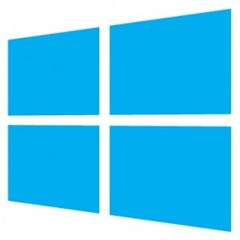
Nearly all mobile devices (not necessarily cell phones, but anything that’s mobile enough) these days have sensors. And that will be our topic for today.
By the way, the way the term “mobile” is used today, reminds me an old anecdote with lady asking an IT guy, who tried to explain the difference between floppy disk and hard disk, whether that floppy disk isn’t hard enough for him. So, let’s settle on the definition that mobile devices are not stationery.
As we found previously, Windows 8 supports many platforms, and each platform has it’s own sensors, and new sensors are invented and need to be supported by OS.
Also, you may find out that your mobile device has more sensors than listed in your device specs. For instance, you may enjoy such sensors as compass and inclinometer, even though you have no such hardware in your device, and that’s because some sensors are “fusion”, or “virtual” – i.e. their data are results of computational analysis of data from other, “real” or “raw” sensors.
More...
by Dmitry Kirsanov
30. December 2012 07:19
As you, perhaps, already know, in Windows 8 you can develop Windows Store applications by using one of 3 ways:
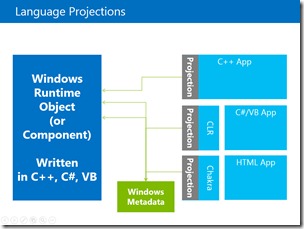
It’s either C++ native application using DirectX, or C# / VB .NET application using XAML, or HTML5 / CSS3 / JavaScript application.
Although Microsoft says that it’s more a matter of style, there are some advantages and disadvantages in using each of these methods and we are going to discuss them now.
As you know, Windows 8 is the first Microsoft’s operating system whose kernel works on servers, workstations, tablets and even mobile phones, which means that it supports a lot of scenarios beyond the scope of any single platform. Windows 8 shares it’s kernel with Windows Server 2012 (servers), Windows RT (ARM based tablets) and Windows Phone 8 (mobile phones), but fortunately you can’t build application that would work on each platform without changes. This reminds me Linux (shares kernel with Android) and MacOS (shares kernel with iOS) – even though at low level it’s the same OS, what’s stands on the shoulders of that kernel is what makes real difference. As Ludwig Mies van der Rohe said, “the God is in the details”.
More...
by Dmitry Kirsanov
16. November 2012 22:34
New technologies allow us to reach new goals. Different tool sets enrich scenarios and it becomes easy to do things we couldn’t dream about before. We implement features so fast, that sometimes we just can’t analyze the impact until the most loyal customers uninstall our app.
Once upon a time I’ve downloaded the mobile application which made my phone a toy that could be handed to a kid. Just like the Kid’s Corner in Windows Phone 8, but for Android. It contained a few badly written games, but it was not the reason why I uninstalled it.
In Android, just like in Windows 8, you can use other apps to enrich your application with their services. Connect to social networks, send e-mails and whatever else.
What this particular application did – it used my e-mail application to send e-mail to developer of that application, to automatically register me as it’s user. I realized that only when I’ve received an e-mail with the password and warm “thank you” for registration which I didn’t commit or solicit.
In some countries that’s crime which could cost you your business.
The morale is – sometimes you can’t do what you can do. You can use contracts in Windows 8 (or their analogs in Android and iOS), but you shouldn’t do anything that your customer is not aware of and can’t cancel before it happens.
by Dmitry Kirsanov
14. November 2012 19:29
Here is a short story of a good idea gone bad, and a good lesson for mobile application developers.
The Preamble
We find ideas everywhere. The best place to find a good idea is where you wouldn’t look for it. The dump, graveyard, museum, park or simply the street of your city at night (in other words – any uncommon place for you) may bring something that would keep you busy for the next year. Or show the pitfall to avoid, and sometimes this knowledge comes with the price.
More...